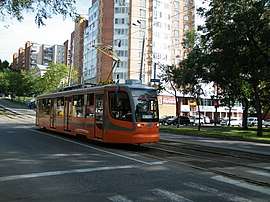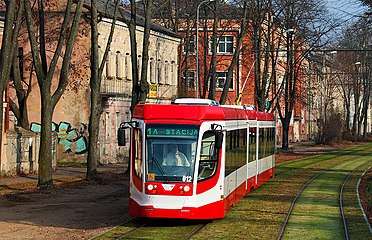Ust-Katav Wagon-Building Plant
Ust-Katav Wagon-Building Plant (Russian: Усть-Катавский вагоностроительный завод имени С. М. Кирова, romanized: Ust'-Katavskiy Vagonostroitel'nyy Zavod imeni S. M. Kirova) is a railroad carriage works in Ust-Katav, Chelyabinsk Oblast, Russia.
 | |
Native name | ФГУП "УКВЗ" |
|---|---|
| Federal State Unitary Enterprise | |
| Industry | Tramcars and Light rail |
| Founded | 1758 |
| Headquarters | , |
Area served | CIS and Eastern Europe |
| Parent | Khrunichev State Research and Production Space Center |
| Website | www.ukvz.ru |
From 1947 to the end of the 20th century (before the series KTM-8), the factory built trams under the brand name KТМ, which is often used as an informal designation for subsequent models with digital items (e.g. tram 71-619 is also known as KTM-19).
History
The factory was founded in 1758.[1]
The plant built streetcars (trams) from 1901.[2] The first tram was made for Tbilisi. In 1960, the enterprise created a special design office to design tramway rolling stock, which has developed about 20 models of trams. The factory set a world record for the number of cars produced for one model (14,991 cars of model KTM-5 M (71-605)).
Currently, the plant produces low-floor trams of different variations of models 71-623 and 71-631. In 2006 the factory built the first of a low-floor articulated tram car type 71-630 (trialled in Moscow). In 2009 UKVZ released two partially low-floor single-sided single-section cars of type 71-623, which went on trial in Ufa and Nizhny Novgorod. Additional trams of these models were built in 2010 for Moscow, Perm, Nizhnekamsk and Krasnodar. The plant also produces spare parts for trams and manufacturing service maintenance of trams.
In addition to trams, the plant produces gas pressure regulating equipment, pipe fittings, pumps, consumer goods.
In accordance with the Decree of the President of the Russian Federation dated 11 June 2011 number 772 and the Federal Government on July 7, 2011 № 1159-r of the Federal State Unitary Enterprise Ust-Katavsky Car Building Plant Kirov was converted into a branch of Federal State Unitary Enterprise Khrunichev State Research and Production Space Center.
Products
- H(M) (1937-1941), two-axle tram. Production of this model was transferred to Mytischenskogo machine factory (now "Metrovagonmash"), where it was produced in 1927.
- KTM/KTP-1 (1947-1961), two-axle tram with all-metal monocoque body.
- KTM-2/KTP-2 (1958-1969), two-axle tram with a metal body.
- KTM-5 (71-605; 1969–1992), four-axle tram with single-leaf sliding doors. Nearly 15,000 cars of this type were built, which allowed them to become the most popular model tramcar in the world. They have been used in many tram systems in Russia are the only type of rolling stock in some of them.
- 71-608 (KTM-8; 1988–2007), four-axle tram. The tram KTM-8 is used in many Russian cities, as well as the CIS. In Moscow, it still remains one of the most common types of rolling stock.
- 71-611 (KTM-11, 1992–1995) - Russian passenger vysokopolny sided (doors on both sides, designed for traction in the backs of cars multiple-unit train control) tram car with the body of the 71-608 is designed for use on light-rail lines.
- 71-619 (KTM-19; 1999–2012), four-axle tram. Used in many Russian cities, as well as in the countries of the CIS.
- 71-623 (71-623; from 2009), four-axle tram with a variable level of the floor.
- 71-630
- 71-631 (from 2011), six-axle articulated three-section tram. At the moment, six cars have been built; they are operated in St. Petersburg.
- 71-633
Gallery
- X-Series museum wagon in Barnaul
_tram_in_Nizhny_Novgorod.jpg) 71-605 (KTM-5) tram in Nizhny Novgorod, Russia
71-605 (KTM-5) tram in Nizhny Novgorod, Russia Tram 71-608K. Chelyabinsk
Tram 71-608K. Chelyabinsk_(at_number_T202)_in_Angarsk.jpg) Tram 71-619 in Angarsk
Tram 71-619 in Angarsk Tram 71-623 in Khabarovsk
Tram 71-623 in Khabarovsk 71-631 tram in Daugavpils
71-631 tram in Daugavpils
References
- How to find this website and how to navigate it - Khrunichev Space Center, then → About the Company → Corporate Structure → Ust-Katav Carriage Plant Named for S.M.Kirov (UKVZ)
- How to find this website and how to navigate it - Khrunichev Space Center, then → About the Company → Corporate Structure → Ust-Katav Carriage Plant Named for S.M.Kirov (UKVZ)
External links
| Wikimedia Commons has media related to KTM trams. |